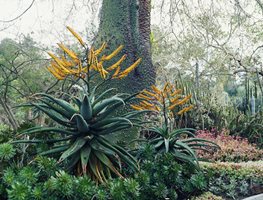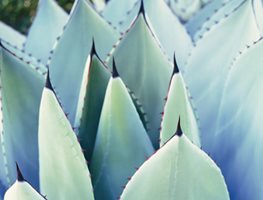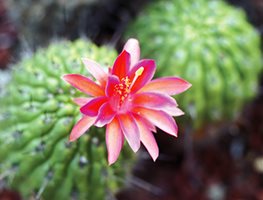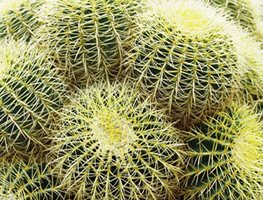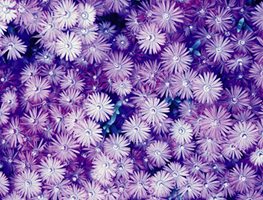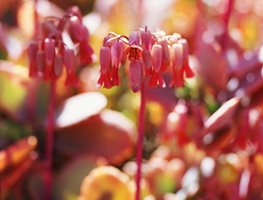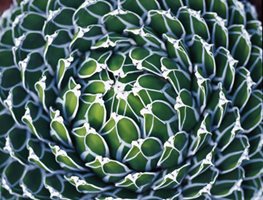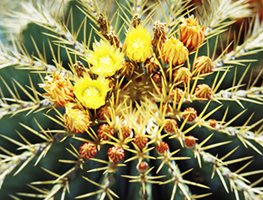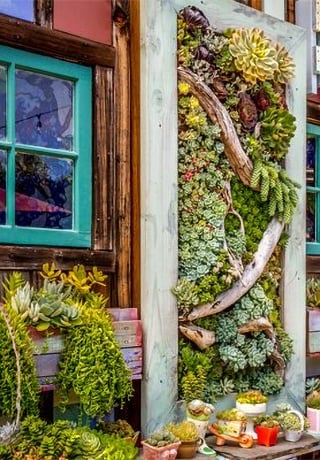Spine Tinglers at the Huntington Botanical Gardens
Learn how cacti and succulents add drama to gardens and containers.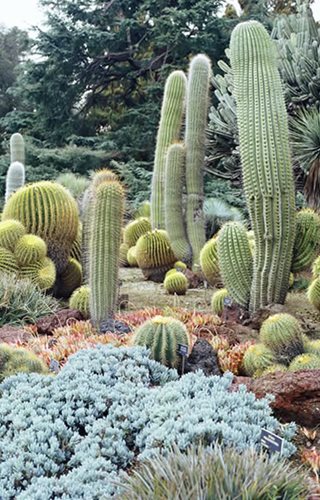
A cactuscape interplays a carpet of blue Senecio serpens, bright-yellow Echinocactus grusonii and candelabra-like pasacana (Echinopsis pasacana or Trichocereus pasacana). From South America, pasacana resembles the native saguaro of the Southwest (Carnegiea gigantea); it also flowers nocturnally. Photo by: Jennifer Cheung.
For inspiration from or indoctrination into the amazing world of succulents, look no further than the Desert Garden at the Huntington Botanical Gardens in San Marino, California. Its 10-plus acres are home to 4,000 different kinds of cacti and succulents, grown in a naturalistic landscape setting. (Succulents are plants that store moisture to survive drought; most cacti are succulents.) With parts of the garden nearly 100 years old, the collection has long been a plant proving ground for garden designers.
AppealCall it living geometry—the dramatic shapes of cactus, the elegant arrangements of succulent spines are endlessly fascinating. Also prized are such things as the soft pastel colors of kalanchoe and shimmering sheets of flowering “mesembs” (from mesembryanthemum, meaning “noonday flowering”) in the dead of winter. Perhaps best of all is a dull-looking cactus bursting forth with spectacular red flowers that attract more photographers than insects.
ZonesThe Huntington is in USDA Zone 10. Most succulents are good outdoors in Zones 9–10. Some yuccas and opuntias tolerate winter conditions typical of southern Canada. Consider cacti and succulents for movable containers in colder climates.
ExposureFull sun is best for hardy Southwest natives. Soft-leaved succulents (such as kalanchoe) prefer filtered afternoon light. In general, select a site offering full sun in the morning, light shade in the afternoon.
SoilMost succulents prefer raised beds or rockeries. Sandy loam is ideal, allowing water to drain quickly. Improve heavy soil by adding equal amounts of coarse builder’s sand and gravel.
CareThe rule of thumb is, water when soil is dry. But unthirsty barrel cacti require water at intervals of just one to two months and none at all during the winter. Fertilize in spring and summer with a balanced 10-10-10 fertilizer.
Tips for Using Succulents
- When transplanting or potting cacti, use the thickest welder’s gloves you can find.
- Check with your neighbors before setting out prickly or large specimens, such as opuntia, on property lines.
- On a similar point, be sure you know the size to which your plants will grow. Provide plenty of room for agaves and yuccas, and don’t position them close to paths. Ouch!
- Subtropical types, such as kalanchoe, look best in tropical situations rather than hot, dry regions. Work them in with shade-loving plants.
- Agave, aloe and opuntia—planted as large accents—add sculptural drama to a water-wise garden.
Read on for 13 succulent and cacti varieties grown at the Huntington:
[1] ALOE ‘HENRY HUNTINGTON’ close up reveals a dramatic golden-yellow inflorescence up to 6 feet tall. And it’s a repeat bloomer. Developed by the Huntington, the plant forms a showy single-headed accent 8 to 12 feet tall.
[2] ALOE MARLOTHII, from South Africa, with whorls of spiky leaves, produces canary-yellow or orange flowers adapted to bird pollination. Makes a 15-foot plant, good specimen for large pot or garden accent. Behind, Chorisia speciosa (Brazilian floss silk tree).
[3] AGAVE PARRYI VAR. PARRYI, with black awl-shaped spines at ends of pudgy gray leaves, can take the cold of Zone 7—it is native to the Chihuahuan Desert. A slow grower to 30 inches in diameter, then after 25 to 35 years it sends up an elegant tree-like flower stalk.
[4] MATUCANA INTERTEXTA is a small globular cactus from Peru, with starry red flowers in spring. Grown outdoors at the Huntington, but is best as a pot plant. It does better in a coastal environment with cooler summers.
[5] ECHINOCACTUS GRUSONII is the famous golden barrel cactus. It thrives in full sun. Good rockery accent or great in a pot. Plant forms a barrel up to 2 feet across, eventually a mound of offsets up to 4 feet in diameter. Zones 7–10.
[6] LAMPRANTHUS AURANTIACUS, a popular groundcover in Southern California, is also useful as an accent or even a potted specimen. Sheets of golden-yellow flowers appear in late winter and early spring.
[7] DROSANTHEMUM HISPIDUM, a South African “mesemb,” is reported to grow outdoors in Colorado, but thrives as a full-sun, 8-inch-high groundcover in Zones 8–10. In late spring it is covered with a carpet of brilliant pink flowers. Not good for stabilizing hillsides, although frequently used there—its roots are too shallow to bind the soil.
[8] ECHEVERIA X IMBRICATA, introduced in the 1890s, is a sculptural heritage succulent with soft, pastel pinkish-blue leaves. Thrives in Zones 9 and 10 as a rockery plant in semishade. Becomes mound forming and can be propagated by offsets. Water when leaves become soft.
[9] KALANCHOE FEDTSCHENKOI makes a sprawling groundcover or pot plant in Southern California, where it takes light frosts. Cool temperatures add a pink blush to the leaves. If it gets rangy, replant with tip cuttings in fall or early spring.
[10] AGAVE VICTORIAE-REGINAE, Queen Victoria agave, forms a solitary ornately decorated rosette that grows up to 24 inches in diameter. Grow it as a rockery showpiece or a pot plant in Zones 8–10. Wait 35 to 45 years for it to flower.
[11] FEROCACTUS GLAUCESCENS, similar to the golden barrel (both from Mexico) but smaller and eventually offsets to form spiny clusters 2 to 3 feet across. Use as an accent or put in a pot.
[12] ALOE ‘SOPHIE’ is named for my daughter—both delightful and unpredictable! ‘Sophie’ the aloe is a repeat bloomer, a feature rare in aloes, and produces showy canary-yellow blossoms. Performs well in full sun and semishade. Takes temperatures in the high 20s.
[13] MAMMILLARIA HAAGEANA, a Mexican pincushion cactus, has tiny star-like pink flowers as early as February.
Huntington Botanical Gardens: (626) 405-2100; www.huntington.org
See more Southern California gardens
Find more gardens: Top 20 Public and Botanical Gardens in the U.S.

